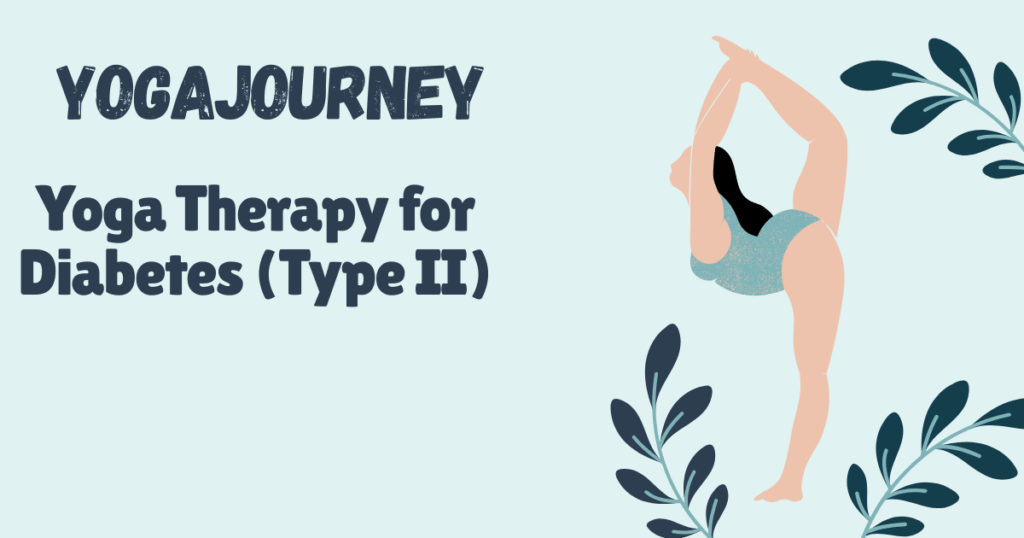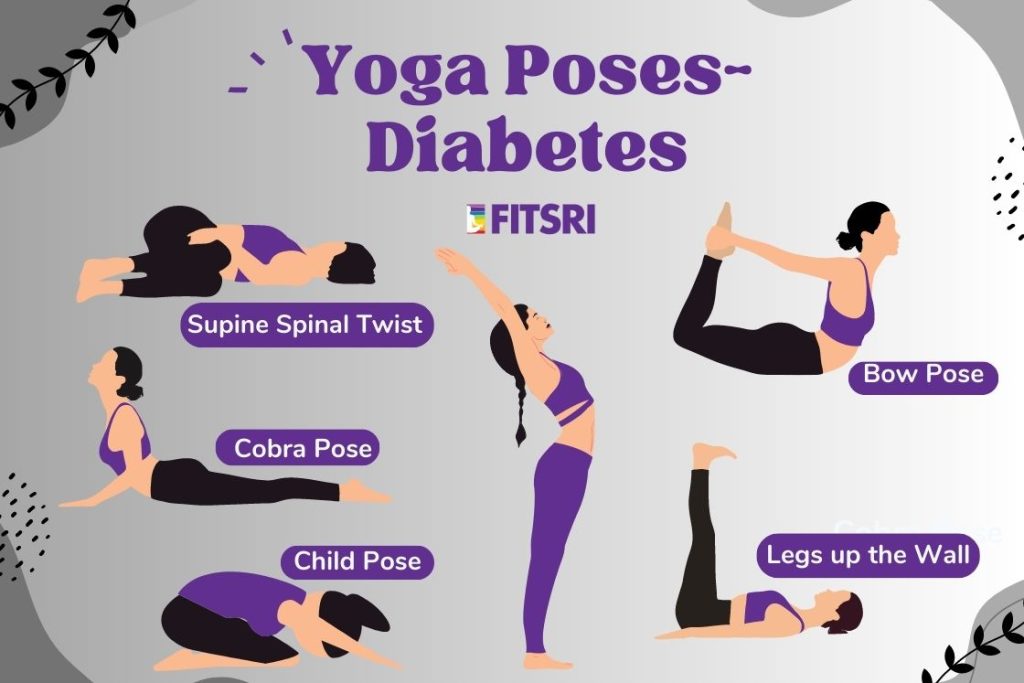
Yoga and Diabetes: A Natural Way to Manage and Reverse the Disease
Diabetes is a complex condition that affects how the body regulates insulin and glucose (sugar), causing numerous metabolic imbalances. With over 18 million Americans currently affected by diabetes, it has reached epidemic levels. Although diabetes is often seen as a chronic, irreversible condition, simple lifestyle changes—such as incorporating yoga, a balanced diet, and regular exercise—can significantly improve blood sugar regulation and may even reverse the condition, particularly in its early stages.
Yoga, in particular, offers a holistic approach to diabetes management. Not only does it promote a healthy lifestyle, but it also directly affects the endocrine system, improves circulation, reduces stress, and stimulates the pancreas, which is responsible for insulin production.
In this article, we’ll explore how yoga can be used as an effective tool in managing diabetes, recommend the best yoga poses for diabetes, and highlight how reducing stress through yoga can improve blood sugar regulation.
Yoga for Diabetes Management: How It Works

Yoga benefits those with diabetes in several ways:
- Improves Insulin Sensitivity: Yoga helps activate insulin-producing cells in the pancreas, making the body more responsive to insulin. This is crucial for managing blood sugar levels.
- Reduces Stress: Chronic stress elevates cortisol levels, which in turn leads to insulin resistance and disrupted blood sugar control. Yoga and pranayama (breathing exercises) help reduce cortisol levels, calming the nervous system and preventing blood sugar spikes.
- Supports Weight Management: Yoga aids in weight loss by promoting metabolism, muscle toning, and overall physical health. Maintaining a healthy weight is essential for managing diabetes and reducing the risk of complications.
- Improves Circulation: Yoga enhances blood circulation, which is especially important for people with diabetes, as poor circulation can lead to complications like nerve damage and poor wound healing.
- Encourages Mindful Eating and Healthy Lifestyle Choices: Yoga encourages a mindful approach to eating, promoting healthier food choices and improving digestion.
Best Yoga Poses for Diabetes

Certain yoga poses have been shown to directly benefit people with diabetes by stimulating the pancreas and supporting overall blood sugar regulation. Here are some of the best poses for managing and improving diabetes:
1. Bow Pose (Dhanurasana)
- Why it works: This backbend stimulates the abdominal organs, including the pancreas, improving its ability to produce insulin. It also strengthens the entire body and enhances circulation.
- How to do it: Lie on your stomach, bend your knees, and grab your ankles with your hands. Lift your chest and legs off the floor while pulling your ankles toward your back. Hold for a few breaths, then release.
2. Half Seated Twist (Ardha Matsyendrasana)
- Why it works: Twisting poses help massage the abdominal organs, including the pancreas, and aid in digestion. This pose also helps detoxify the body.
- How to do it: Sit with one leg extended and the other leg bent across it. Twist your torso toward the bent knee, placing the opposite arm on the knee. Hold for a few breaths, then switch sides.
3. Seated Forward Fold (Paschimottanasana)

- Why it works: This forward bend stretches the spine and improves circulation. It also has a calming effect on the nervous system, reducing stress levels.
- How to do it: Sit with your legs extended straight in front of you. Hinge at your hips and reach forward to grab your feet or ankles, keeping your spine long. Hold for several breaths.
4. Plow Pose (Halasana)
- Why it works: Plow Pose helps stimulate the pancreas and promotes digestive health. It also enhances circulation to the entire body.
- How to do it: Lie on your back and lift your legs over your head, trying to touch the floor with your feet. Keep your arms on the floor for support and engage your core.
5. Downward-Facing Dog (Adho Mukha Svanasana)
- Why it works: This pose activates the entire body, including the arms, legs, and spine. It stimulates blood flow and improves circulation.
- How to do it: Start in a plank position, then lift your hips toward the ceiling, forming an inverted V-shape. Keep your hands and feet pressed firmly into the floor and relax your neck.
6. Cobra Pose (Bhujangasana)
- Why it works: Cobra Pose strengthens the spine and stimulates the pancreas, which aids in regulating insulin levels.
- How to do it: Lie on your stomach, place your hands under your shoulders, and gently lift your chest off the floor, extending your arms. Hold for a few breaths.
Stress and Diabetes: A Dangerous Link

Stress is a significant trigger for high blood sugar, as it increases the production of cortisol, the body’s primary stress hormone. Elevated cortisol levels can lead to insulin resistance, making it more difficult for the body to regulate blood sugar. This creates a dangerous cycle, as stress can raise blood sugar levels, which in turn causes more stress and anxiety.
Yoga helps break this cycle by lowering cortisol levels and promoting relaxation. Some effective yoga poses for stress reduction include:
1. Child’s Pose (Balasana)
- A gentle, restorative pose that calms the nervous system and releases tension in the body.
2. Supine Bound Angle (Supta Baddha Konasana)
- This pose opens the hips and chest, promoting relaxation and helping reduce anxiety.
3. Knee-Down Twist (Supta Matsyendrasana)
- A gentle twist that releases tension in the spine and promotes mental clarity.
4. Half Pyramid Pose (Ardha Parsvottanasana)
- A forward bend that stretches the hamstrings and reduces stress while calming the mind.
5. Pranayama (Breathing Exercises)
- Dirga Pranayama (Three-Part Breath) and Nadi Sodhana (Alternate Nostril Breathing) are particularly effective at reducing stress and bringing balance to the nervous system.
Diet and Lifestyle for Diabetes Management

In addition to yoga, diet plays a significant role in managing blood sugar levels. A yogic diet, rich in fiber, whole foods, beans, vegetables, and moderate dairy, can help stabilize blood sugar. Consuming foods high in fiber and low in processed sugars will improve insulin sensitivity and support overall metabolic health.
Avoid the following:
- Refined sugars and processed foods
- Excessive caffeine, alcohol, and nicotine
- High-sodium foods and excessive animal protein
Incorporate the following:
- Whole grains (brown rice, quinoa, oats)
- Leafy greens (spinach, kale)
- Nuts and seeds (almonds, chia seeds)
- Healthy fats (avocado, olive oil)
- Low-fat dairy (or dairy alternatives like almond milk)
Additionally, maintaining an active lifestyle that includes regular exercise such as walking or swimming will further improve insulin sensitivity and keep blood sugar levels stable.
Important Reminder

While yoga is an effective tool in managing diabetes, it is not a substitute for medical treatment. Always consult your healthcare provider before starting any new exercise program, especially if you are on diabetes medication.
Safety Tips:
- Eat a small meal 1-2 hours before yoga to avoid low blood sugar.
- Check your blood sugar before and after practicing yoga to monitor changes.
- Keep a snack (like fruit or nuts) nearby in case your blood sugar drops during or after yoga.
Conclusion: Yoga as a Powerful Tool for Managing Diabetes

Yoga is a holistic, natural way to manage and even reverse diabetes when combined with a healthy diet and lifestyle. By improving insulin sensitivity, reducing stress, enhancing circulation, and promoting mindful eating habits, yoga can be a game-changer in diabetes management. With regular practice, yoga can help stabilize blood sugar levels, improve overall health, and provide relief from diabetes-related symptoms.
Always work with your healthcare provider to create a comprehensive diabetes management plan that includes exercise, a balanced diet, and, when necessary, medication. Yoga, however, can play a crucial role in improving quality of life and supporting long-term health.
